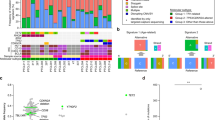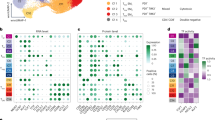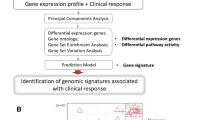Abstract
Nuclear factor kappa B (NF-κB) is one important pathway in T-cell proliferation and survival. In a previously reported microarrray study, we found NF-κB pathway genes differentially expressed between peripheral (PTCL) and lymphoblastic lymphomas. Here, we investigated the expression of NF-κB pathway genes using cDNA microarrays in a group of 62 PTCL and in reactive lymph nodes. We found two different subgroups of PTCL based on the expression of NF-κB pathway genes. One-third of PTCL showed clearly reduced expression of NF-κB genes, while the other group was characterized by high expression of these genes. This distinction was found among all T-cell lymphoma categories analyzed (PTCL unspecified, angioimmunoblastic, cutaneous and natural killer/T lymphomas) with the exception of anaplastic lymphomas (ALCL), which were characterized by reduced NF-κB expression in anaplastic cells. Quantitative RT-PCR and immunohistochemical analysis of NF-κB-p65 protein confirmed these differences among PTCL subgroups. Importantly, we found that differentiation between NF-κB-positive and -negative PTCL could be of clinical interest. The expression profile associated to reduced expression of NF-κB genes was significantly associated with shorter survival of patients and seems to be an independent prognostic factor in a multivariate analysis.
This is a preview of subscription content, access via your institution
Access options
Subscribe to this journal
Receive 12 print issues and online access
$259.00 per year
only $21.58 per issue
Buy this article
- Purchase on Springer Link
- Instant access to full article PDF
Prices may be subject to local taxes which are calculated during checkout





Similar content being viewed by others
References
Harris NL, Jaffe ES, Stein H, Banks PM, Chan JK, Cleary ML et al. A revised European-American classification of lymphoid neoplasms: a proposal from the International Lymphoma Study Group. Blood 1994; 84: 1361–1392.
Armitage JO, Weisenburger DD . New approach to classifying non-Hodgkin's lymphomas: clinical features of the major histologic subtypes. Non-Hodgkin's Lymphoma Classification Project. J Clin Oncol 1998; 16: 2780–2795.
Martinez-Delgado B, Melendez B, Cuadros M, Alvarez J, Castrillo JM, Ruiz De La Parte A et al. Expression profiling of T-cell lymphomas differentiates peripheral and lymphoblastic lymphomas and defines survival related genes. Clin Cancer Res 2004; 10: 4971–4982.
Ghosh S, May MJ, Kopp EB . NF-kappa B and Rel proteins: evolutionarily conserved mediators of immune responses. Annu Rev Immunol 1998; 16: 225–260.
Li Q, Verma IM . NF-kappaB regulation in the immune system. Nat Rev Immunol 2002; 2: 725–734.
Karin M, Ben-Neriah Y . Phosphorylation meets ubiquitination: the control of NF-[kappa]B activity. Annu Rev Immunol 2000; 18: 621–663.
Baldwin AS . Control of oncogenesis and cancer therapy resistance by the transcription factor NF-kappaB. J Clin Invest 2001; 107: 241–246.
Rayet B, Gelinas C . Aberrant rel/nfkb genes and activity in human cancer. Oncogene 1999; 18: 6938–6947.
Turco MC, Romano MF, Petrella A, Bisogni R, Tassone P, Venuta S . NF-kappaB/Rel-mediated regulation of apoptosis in hematologic malignancies and normal hematopoietic progenitors. Leukemia 2004; 18: 11–17.
Shishodia S, Aggarwal BB . Nuclear factor-kappaB: a friend or a foe in cancer? Biochem Pharmacol 2004; 68: 1071–1080.
Kasibhatla S, Brunner T, Genestier L, Echeverri F, Mahboubi A, Green DR . DNA damaging agents induce expression of Fas ligand and subsequent apoptosis in T lymphocytes via the activation of NF-kappa B and AP-1. Mol Cell 1998; 1: 543–551.
Alizadeh AA, Eisen MB, Davis RE, Ma C, Lossos IS, Rosenwald A et al. Distinct types of diffuse large B-cell lymphoma identified by gene expression profiling. Nature 2000; 403: 503–511.
Davis RE, Brown KD, Siebenlist U, Staudt LM . Constitutive nuclear factor kappaB activity is required for survival of activated B cell-like diffuse large B cell lymphoma cells. J Exp Med 2001; 194: 1861–1874.
Izban KF, Ergin M, Qin JZ, Martinez RL, Pooley RJ, Saeed S et al. Constitutive expression of NF-kappa B is a characteristic feature of mycosis fungoides: implications for apoptosis resistance and pathogenesis. Hum Pathol 2000; 31: 1482–1490.
Tracey L, Villuendas R, Dotor AM, Spiteri I, Ortiz P, Garcia JF et al. Mycosis fungoides shows concurrent deregulation of multiple genes involved in the TNF signaling pathway: an expression profile study. Blood 2003; 102: 1042–1050.
Horie R, Watanabe M, Ishida T, Koiwa T, Aizawa S, Itoh K et al. The NPM-ALK oncoprotein abrogates CD30 signaling and constitutive NF-kappaB activation in anaplastic large cell lymphoma. Cancer Cell 2004; 5: 353–364.
Jaffe ES . Anaplastic large cell lymphoma: the shifting sands of diagnostic hematopathology. Mod Pathol 2001; 14: 219–228.
Morris SW, Kirstein MN, Valentine MB, Dittmer KG, Shapiro DN, Saltman DL et al. Fusion of a kinase gene, ALK, to a nucleolar protein gene, NPM, in non-Hodgkin's lymphoma. Science 1994; 263: 1281–1284.
Horie R, Watanabe T, Morishita Y, Ito K, Ishida T, Kanegae Y et al. Ligand-independent signaling by overexpressed CD30 drives NF-kappaB activation in Hodgkin–Reed–Sternberg cells. Oncogene 2002; 21: 2493–2503.
Bargou RC, Leng C, Krappmann D, Emmerich F, Mapara MY, Bommert K et al. High-level nuclear NF-kappa B and Oct-2 is a common feature of cultured Hodgkin/Reed–Sternberg cells. Blood 1996; 87: 4340–4347.
Tracey L, Villuendas R, Ortiz P, Dopazo A, Spiteri I, Lombardia L et al. Identification of genes involved in resistance to interferon-alpha in cutaneous T-cell lymphoma. Am J Pathol 2002; 161: 1825–1837.
Yang YH, Dudoit S, Luu P, Lin DM, Peng V, Ngai J et al. Normalization for cDNA microarray data: a robust composite method addressing single and multiple slide systematic variation. Nucleic Acids Res 2002; 30: e15.
Herrero J, Valencia A, Dopazo J . A hierarchical unsupervised growing neural network for clustering gene expression patterns. Bioinformatics 2001; 17: 126–136.
Kononen J, Bubendorf L, Kallioniemi A, Barlund M, Schraml P, Leighton S et al. Tissue microarrays for high-throughput molecular profiling of tumor specimens. Nat Med 1998; 4: 844–847.
Rosenwald A, Wright G, Chan WC, Connors JM, Campo E, Fisher RI et al. The use of molecular profiling to predict survival after chemotherapy for diffuse large-B-cell lymphoma. N Engl J Med 2002; 346: 1937–1947.
Yeoh EJ, Ross ME, Shurtleff SA, Williams WK, Patel D, Mahfouz R et al. Classification, subtype discovery, and prediction of outcome in pediatric acute lymphoblastic leukemia by gene expression profiling. Cancer Cell 2002; 1: 133–143.
Dyrskjot L, Thykjaer T, Kruhoffer M, Jensen JL, Marcussen N, Hamilton-Dutoit S et al. Identifying distinct classes of bladder carcinoma using microarrays. Nat Genet 2003; 33: 90–96.
Giri DK, Aggarwal BB . Constitutive activation of NF-kappaB causes resistance to apoptosis in human cutaneous T cell lymphoma HuT-78 cells. Autocrine role of tumor necrosis factor and reactive oxygen intermediates. J Biol Chem 1998; 273: 14008–14014.
Kane LP, Lin J, Weiss A . Signal transduction by the TCR for antigen. Curr Opin Immunol 2000; 12: 242–249.
Frauwirth KA, Thompson CB . Activation and inhibition of lymphocytes by costimulation. J Clin Invest 2002; 109: 295–299.
Zheng Y, Vig M, Lyons J, Van Parijs L, Beg AA . Combined deficiency of p50 and cRel in CD4+ T cells reveals an essential requirement for nuclear factor kappaB in regulating mature T cell survival and in vivo function. J Exp Med 2003; 197: 861–874.
Bargou RC, Emmerich F, Krappmann D, Bommert K, Mapara MY, Arnold W et al. Constitutive nuclear factor-kappaB-RelA activation is required for proliferation and survival of Hodgkin's disease tumor cells. J Clin Invest 1997; 100: 2961–2969.
Ivanov VN, Ronai Z . p38 protects human melanoma cells from UV-induced apoptosis through down-regulation of NF-kappaB activity and Fas expression. Oncogene 2000; 19: 3003–3012.
Seitz CS, Lin Q, Deng H, Khavari PA . Alterations in NF-kappaB function in transgenic epithelial tissue demonstrate a growth inhibitory role for NF-kappaB. Proc Natl Acad Sci USA 1998; 95: 2307–2312.
Acknowledgements
This work was supported by grants from the Comunidad Autonoma de Madrid CAM 08.6/0005.1/2001 and Fondo Investigaciones Sanitarias FIS G03/179. MC and EH are fellows of the Fondo de Investigación Sanitaria (FIS). We thank all the people involved in the Spanish Cooperative Group for the Study of T-cell lymphomas for their collaboration. We thank Victoria Fernandez and Alicia Barroso for their excellent technical assistance, the CNIO Histology and Immunohistochemistry Unit, and Amanda Wren for kindly reviewing the manuscript. We also thank the CNIO Tumour Bank for help in providing tumour samples.
Author information
Authors and Affiliations
Consortia
Corresponding author
Additional information
Supplementary Information
Supplementary Information accompanies the paper on the Leukemia website (http://www.nature.com/leu).
Supplementary information
Rights and permissions
About this article
Cite this article
Martínez-Delgado, B., Cuadros, M., Honrado, E. et al. Differential expression of NF-κB pathway genes among peripheral T-cell lymphomas. Leukemia 19, 2254–2263 (2005). https://doi.org/10.1038/sj.leu.2403960
Received:
Accepted:
Published:
Issue Date:
DOI: https://doi.org/10.1038/sj.leu.2403960
Keywords
This article is cited by
-
Phase 1 trial of carfilzomib in relapsed/refractory peripheral T-cell lymphoma
Annals of Hematology (2022)
-
Fusion transcripts FYN-TRAF3IP2 and KHDRBS1-LCK hijack T cell receptor signaling in peripheral T-cell lymphoma, not otherwise specified
Nature Communications (2021)
-
FYN–TRAF3IP2 induces NF-κB signaling-driven peripheral T-cell lymphoma
Nature Cancer (2021)
-
Identification of Hub Genes and Key Pathways Associated with Peripheral T-cell Lymphoma
Current Medical Science (2020)
-
Molecular Insights Into Pathogenesis of Peripheral T Cell Lymphoma: a Review
Current Hematologic Malignancy Reports (2018)



